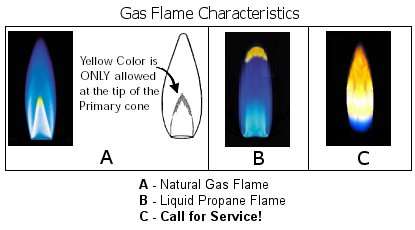What a gas cooking appliance's flames should look like will depend on whether it is burning natural gas or propane (LP). You can see examples of each below.

Gas Range Flame Characteristics
When burning natural gas, the burner flames should be almost completely blue with possibly a small hint of yellow in the center of the flame as seen in figure "A" above. When burning liquid propane (LP), the flames will usually have a yellow tip as seen in figure "B".
If the flames are mostly yellow (figure "C"), it indicates a problem in which case use of the appliance should be discontinued and a licensed gas appliance service technician should be called to check it out and correct the problem. This condition can also cause sooting to appear on the bottoms of cookware.
Gas Flame Diagnostics
For many of the improper flame conditions which may be encountered on a gas range or cooktop, you can read possible causes and what actions may be necessary to correct the condition below. *Actual problems should only be diagnosed and serviced performed by a licensed gas appliance service technician.
Flame is white-blue and has hard, sharp features.
Possible Cause
- Excessive primary air.
Corrective Action
- Adjust air shutter.
Flame is small and blue in color.
Possible Cause
- Clogged burner orifice.
- Clogged venturi.
- Restricted or clogged gas line.
- Excessive low gas pressure.
Corrective Action
- Clean or replace burner orifice.
- Clean venturi. Replace burner, if necessary.
- Remove & clean the gas supply line. Relace, if necessary.
- Use a manometer and adjust the gas pressure.
Flame is yellow and/or causing sooting on cooking utensils.
Possible Cause
- Insufficient primary air.
- Blocked primary air shutter.
- Oversized burner orifice.
Corrective Action
- Increase primary air shutter.
- Clean primary air shutter & adjust for proper air-gas mixture.
- Replace burner orifice.
Flame is noisy (rumbles or gurgles).
Possible Cause
- Excessive primary air.
- Excessive gas pressure.
Corrective Action
- Clean primary air shutter & adjust for proper air-gas mixture.
- Use a manometer and adjust the gas pressure.
Orifice noise (burr or high-pitched squeal).
Possible Cause
- Debris lodged in orifice.
- Improper orifice size.
- Excessive gas pressure.
Corrective Action
- Clean orifice. Replace, if necessary.
- Replace orifice.
- Use a manometer and adjust the gas pressure.
Air intake or mixing noise.
Possible Cause
- Rough area in mixing tube or venturi.
- Loose debris in mixing tube or venturi.
- Burner not seated correctly over orifice. Distance between orifice and venturi too large.
Corrective Action
- Smooth the interior surface. Replace burner, if necessary.
- Clean mixing tube.
- Seat burner over orifice correctly.
Erratic burner flame (fluctuates high to low).
Possible Cause
- Gas regulator flutter.
- Control valve malfunction.
Corrective Action
- Replace pressure regulator, if necessary.
- Adjust regulator on control valve. Replace, if necessary.


